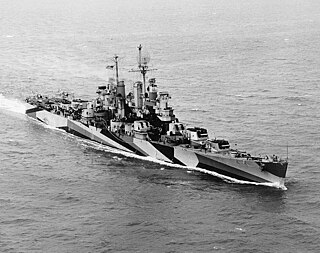
USS Duluth was a United States Navy Cleveland-class light cruiser.
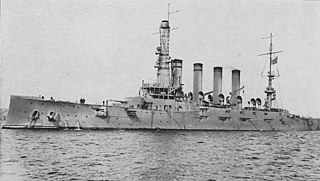
The second USS Maryland (ACR-8/CA-8), also referred to as "Armored Cruiser No. 8", and later renamed Frederick, was a United States Navy Pennsylvania-class armored cruiser.

USS Amsterdam was a United States Navy Cleveland-class light cruiser, the last of the class to see action in World War II.

The second USS Colorado (ACR-7/CA-7), also referred to as "Armored Cruiser No. 7", and later renamed Pueblo, was a United States Navy Pennsylvania-class armored cruiser. She was the second US Navy ship named Colorado, and the first to be named after the state of Colorado. The first, Colorado, was named for the Colorado River.

The third USS Astoria was a Cleveland-class light cruiser of the United States Navy.

The second USS Norfolk (DL-1) was the first destroyer leader of the United States Navy. Originally projected as a hunter-killer cruiser, she was in service until 1970, and was scrapped in 1974.

USS Dayton was a Cleveland-class light cruiser of the United States Navy. The ship was named after the city of Dayton, Ohio.

USS Fargo (CL-106), named after the city of Fargo, North Dakota, was the lead ship of her class of light cruisers of the United States Navy, most of which were canceled due to the end of World War II.
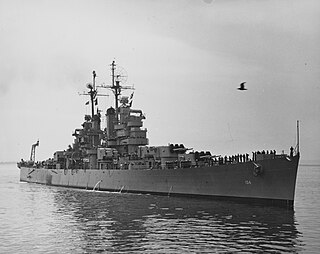
USS Atlanta of the United States Navy was a Cleveland-class light cruiser during World War II. She was the fourth Navy ship named after the city of Atlanta, Georgia.
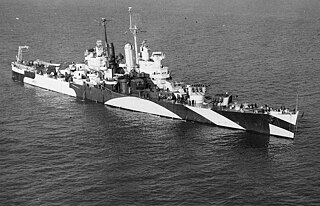
USS Houston (CL-81), was a Cleveland-class light cruiser and the third vessel in the United States Navy named after Houston, Texas. She was active in the Pacific War and survived two separate aerial torpedo hits in October 1944.

USS Birmingham (CL-62), a United States Cleveland-class light cruiser named for the city of Birmingham, Alabama, the "Pittsburgh of the South", was laid down at the Newport News Shipbuilding and Dry Dock Company of Newport News, Virginia, on 17 February 1941 and launched on 20 March 1942 by Mrs. Cooper Green, wife of the president of the Birmingham City Commission. She was commissioned on 29 January 1943, Captain John Wilkes in command. Birmingham earned eight battle stars, receiving heavy damage on at least three occasions.

USS Honolulu (CL-48) of the United States Navy was a Brooklyn-class light cruiser active in the Pacific War. Honolulu was launched in 1937 and commissioned in 1938. The ship served in the Battle of Tassafaronga, the Battle of Kula Gulf, the Battle of Kolombangara and the Battle of Peleliu. She was taken out of action by serious torpedo damage just before the Battle of Leyte Gulf. She was repaired, but not in time to rejoin the war. She was decommissioned in 1947 and was held in reserve until she was scrapped in 1959.

USS Huntington (CL-107), a Fargo-class light cruiser, was the second ship of the United States Navy named after the city of Huntington, West Virginia. She was built during World War II but not completed until after the end of the war and in use for only a few years.

USS Cleveland (CL-55) was the lead ship and one of the 27 United States Navy Cleveland-class light cruisers completed during or shortly after World War II. She was the second ship to be named for the city of Cleveland, Ohio.
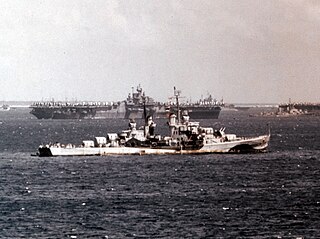
USS Flint (CL-97) was a modified Atlanta-class light cruiser, sometimes referred to as an "Oakland-class". She was named after the city of Flint, Michigan. She was launched on 25 January 1944 by Bethlehem Shipbuilding Corporation of San Francisco, California, sponsored by Mrs. R. A. Pitcher. She was and commissioned on 31 August 1944. She was reclassified CLAA-97 on 18 March 1949.

The second USS Juneau (CL-119/CLAA-119) was the lead ship of the United States Navy Juneau-class cruisers.

USS Portsmouth was a Cleveland-class light cruiser of the United States Navy, the third ship to carry the name.
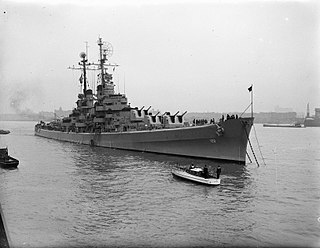
USS Spokane (CL-120/CLAA-120/AG-191) was the second ship of the Juneau-class light cruiser of the United States Navy.

The Juneau-class cruisers were United States Navy light cruisers that were modified version of the Atlanta-class cruiser design. The ships had the same dual-purpose main armament as USS Oakland with a much heavier secondary antiaircraft battery, while the anti-submarine depth charge tracks and torpedo tubes were removed along with a redesigned superstructure to reduce weight and increase stability. Three ships were ordered and built, all completed shortly after World War II, but only Juneau remained active long enough to see action during the Korean War.


















